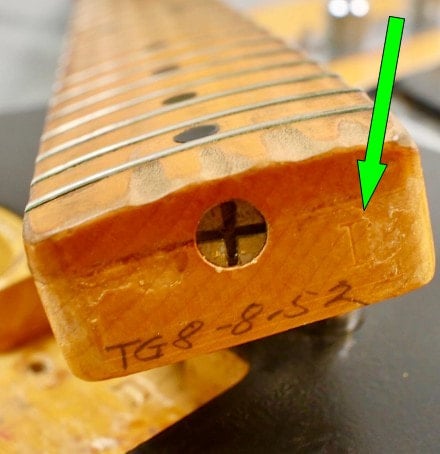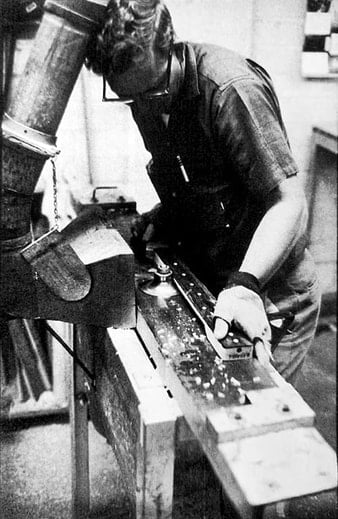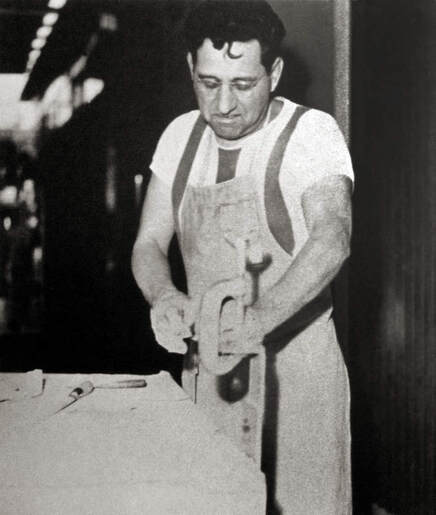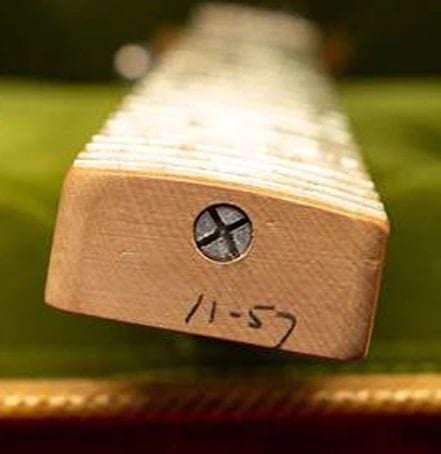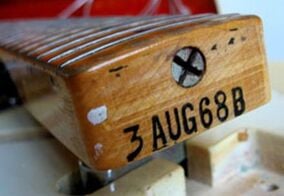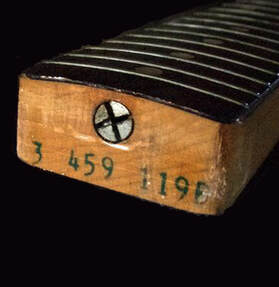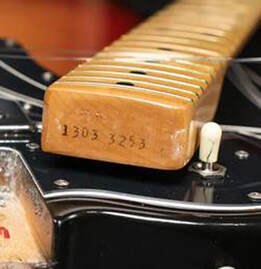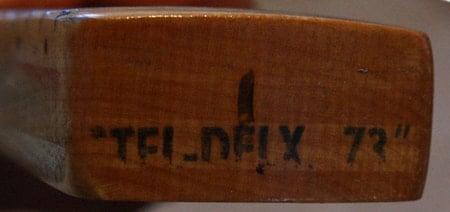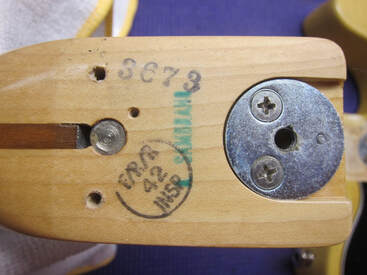Although neck dates preceded the actual completion of an instrument by a few weeks or months, they were commonly considered, whenever available, as point of reference for dating a Fender guitar.
Neck dates, when present, were written on the heel of the neck, under the truss rod bolt. These markings were always written on the bare wood, once the cutting was completed, prior to being finished.
Most Telecaster-style guitar necks have been quite consistently dated at the factory, with the notable exceptions of a few months between Spring 1959 and early 1960 and between Spring 1973 and late 1981. Neck dates are not present on pre-production guitars and on the very first models released prior to October 1950, too. Furthermore, necks marked in October 1950 were dated on their back of the neck heel.
Various dating marks have actually been used at the factory according to the period of production.
Neck dates, when present, were written on the heel of the neck, under the truss rod bolt. These markings were always written on the bare wood, once the cutting was completed, prior to being finished.
Most Telecaster-style guitar necks have been quite consistently dated at the factory, with the notable exceptions of a few months between Spring 1959 and early 1960 and between Spring 1973 and late 1981. Neck dates are not present on pre-production guitars and on the very first models released prior to October 1950, too. Furthermore, necks marked in October 1950 were dated on their back of the neck heel.
Various dating marks have actually been used at the factory according to the period of production.
PENCILED DATES
Until March 1962, neck dates were generally penciled in black - although they may also be found in red (1953/54) or even in green (rare, in 1950) - and indicated in numerals. They are usually separated by either a slash or a hyphen.
Up to the mid-50s, the employee who checked the neck frequently added his initials ahead of the date. The most commonly found are “TG”, which stands for Tadeo Gomez, “DZ,” featured mostly in 1950, which stands for Dickie Zamora, and “XA”, featured mostly in 1956, which stands for Xavier Armenta. Other initials such as “AG” or “TD” also exist, but the names behind them so far remain shrouded in mystery.
In this regard it is important to point out that Tadeo or Xavier never made an entire neck on their own. There are many photos documenting that this always was a manufacturing process involving many people, and not only one employee.
Necks made from mid-1951 until late 1955 sometimes sported a “D” stamp next to the date. Nobody knows its meaning. George Daimler, a former Fender employee, claimed that it stands for “inspected”.
A few collectors supposed “D” stands for “detected”, “done”, “dried” or “checked”. However, it seems that only the necks that came back to the factory to be refinished or modified got this stamp.
Up to the mid-50s, the employee who checked the neck frequently added his initials ahead of the date. The most commonly found are “TG”, which stands for Tadeo Gomez, “DZ,” featured mostly in 1950, which stands for Dickie Zamora, and “XA”, featured mostly in 1956, which stands for Xavier Armenta. Other initials such as “AG” or “TD” also exist, but the names behind them so far remain shrouded in mystery.
In this regard it is important to point out that Tadeo or Xavier never made an entire neck on their own. There are many photos documenting that this always was a manufacturing process involving many people, and not only one employee.
Necks made from mid-1951 until late 1955 sometimes sported a “D” stamp next to the date. Nobody knows its meaning. George Daimler, a former Fender employee, claimed that it stands for “inspected”.
A few collectors supposed “D” stands for “detected”, “done”, “dried” or “checked”. However, it seems that only the necks that came back to the factory to be refinished or modified got this stamp.
- Between October 1950 and late 1953:
The date usually showed the month/day/year in numerals.
For example: “3/23/51” = March 3, 1951
- Between late 1953 and March 1962:
The date was still penciled and indicated in numerals, but the day is no longer systematically mentioned, although it can be found on some 1954 necks.
For example: “11-57” = November 1957
|
8 August 1952 neck, "D" marking (photo courtesy Eddie Tatton) and November 1957 neck (photo courtesy True Vintage Guitar)
|
Vertical Divider
|
It's important to bear in mind that neck dating procedure was suspended for a few months between Spring 1959 and the early 1960. According to legend, this is due to a complaint from a guitarist who had found obscene writings at the base of the neck. It should be noted that body dates were still applied during these months and they are very useful to assess the age of Fender guitars made during this period.
RUBBER-STAMPED DATES
Between March 1962 and March 1973:
|
The date was no longer penciled but rubber-stamped in black, blue, green or even red. A new sophisticated code, which not only shows the first three letters of the month and the last two digits of the year, but also the neck width at the nut and the guitar model, was used. Indeed, in the ‘60s the other sizes were available at an extra cost in addition to the standard one.
|
Telecaster and Esquire necks were identified by the same inventory code prefix, “3”, whilst the letter suffix in indicated the width at the nut:
A means 1 1/2" (1.500") narrow
B means 1 5/8" (1.625") standard
C means 1 3/4" (1.750") wide
D means 1 7/8" (1.875") extra wide
For example a “3AUG68B” means:
“3” = Telecaster/Esquire neck
“AUG” = July
“68” = 1968
“B” = Standard nut width
It does not refer to neck made on July 3, 1965!
A means 1 1/2" (1.500") narrow
B means 1 5/8" (1.625") standard
C means 1 3/4" (1.750") wide
D means 1 7/8" (1.875") extra wide
For example a “3AUG68B” means:
“3” = Telecaster/Esquire neck
“AUG” = July
“68” = 1968
“B” = Standard nut width
It does not refer to neck made on July 3, 1965!
The late ‘60s:
Some necks featured a different kind of numeric code, usually in green with either smaller or taller digits, made of 6, 7 or 8 digits. It was used at the same time as the classic one seen so far.
Some necks featured a different kind of numeric code, usually in green with either smaller or taller digits, made of 6, 7 or 8 digits. It was used at the same time as the classic one seen so far.
Few left-handed necks came without any marking. Also Rosewood Telecasters were often devoid of any neck date, although they sometimes sported a barely visible black ink stamp.
After 1972:
These necks featured an entirely new type of marking. The old code was not dropped until April 1973; hence, for a while two different type of code were used at the same time.
The new numeric eight-digit code was more elaborate and indicated also the fretboard type and the day and the week of production. It may be stamped in black, red or green.
The eight numbers could be divided in two groups, which were sometimes separated by
"x", "-", "•", "½" or "¼".
The first group of 4 digits is meant to indicate the model and the type of fretboard:
“13” = Regular Telecaster
‘‘07” = Telecaster Custom
“08” = Telecaster Deluxe
“30” = Telecaster Thinline
“00” and “01” = Rosewood fretboard
“03” = Maple neck or Rosewood fretboard with skunk stripe and walnut plug
These necks featured an entirely new type of marking. The old code was not dropped until April 1973; hence, for a while two different type of code were used at the same time.
The new numeric eight-digit code was more elaborate and indicated also the fretboard type and the day and the week of production. It may be stamped in black, red or green.
The eight numbers could be divided in two groups, which were sometimes separated by
"x", "-", "•", "½" or "¼".
The first group of 4 digits is meant to indicate the model and the type of fretboard:
“13” = Regular Telecaster
‘‘07” = Telecaster Custom
“08” = Telecaster Deluxe
“30” = Telecaster Thinline
“00” and “01” = Rosewood fretboard
“03” = Maple neck or Rosewood fretboard with skunk stripe and walnut plug
|
1975 Telecaster Custom, courtesy of True Vintage Guitar
|
For example, “1303 3253” stands for:
“13” = Regular Telecaster “03” = Maple neck “32” = Week number 32 “5” = 1975 “3” = Third day of the week (Wednesday) |
Also, during the '70s:
|
Inspection date rubber-stamps were sometimes used on the neck:
|
THE NEW MENAGEMENT
After CBS called in the new management team, with the purpose of highlighting a better quality control on its instruments the old code system was dropped and clear date markings were resumed.
- Since Autumn 1981, a numeric (MM DD YY) rubber-stamped code was used for a short time on standard models.
- In 1983 Fender switched to smaller and more explicit date markings.
For example: “JUN 10 1984”
An "inspection" sticker that indicated also the employee who made the quality check was also used on the back of the neck heel.

